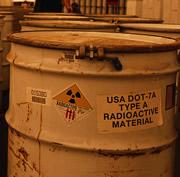A crunch looms in dealing with nuclear waste, and so there's no better time for airing unorthodox solutions. The latest comes from a team of physicists in Germany, who say that radioactive decay might be speeded up by sticking the atoms in metals cooled to within a few degrees of absolute zero.
The claim is disputed by other scientists, although the findings of the German group seem genuinely puzzling. The key question, however, is how we are to deal with such reports. Some techniques for altering the half-lives of radioactive elements have a basis in sound science — but others lurk at the wilder fringes. Can they be told apart?
I've had unusual cause to ponder these questions. A few years ago, I found myself in the rather surreal situation of trying to explain to Madonna why it is generally beyond the means of science to tamper with rates of radioactive decay.
 Dirty job: radioactive waste is tough to deal with.© Getty
Dirty job: radioactive waste is tough to deal with.© GettyShe had heard (don't ask me how) about a team of Russian scientists who claimed to have developed a way to treat water so that it can 'neutralize' radioactive waste. They had data allegedly showing that the process worked on a lake contaminated by the Chernobyl accident. Since I had written a book about water, I was summoned as a putative 'specialist' to discuss the findings.
So there we were: me, Guy Ritchie, 'Mrs R', and a clutch of excited scientists, talking for a couple of hours about a way to eliminate the carcinogenic legacy of nuclear power (or not).
Water works
Madonna has made no secret of her interest in this work — she has been quoted on it in Rolling Stone magazine. I was told soon after our meeting that a California-based company was interested in working with the Russians and Madonna to promote the waste-treatment scheme. But they never got back in touch with me, so I've no idea what came of the plan.
One can hardly blame a non-scientist for being excited by claims of "a way to neutralize radiation". As I tried to explain on that strange afternoon, radioactive decay can't be 'neutralized' in the same way that, say, one might neutralize a nasty acid. Yet that's not to say it is totally beyond our influence.
The Russian scientists suggested that their process might have something to do with the 'quantum Zeno effect', a phenomenon in which quantum probabilities are altered by repeated measurement1,2. In principle it might be possible to exploit this effect; but it is normally tiny, and it's far from obvious how it might be translated into anything remotely useful, let alone how it might be induced by 'electromagnetically processed' water, as suggested by the Russians (who, to my knowledge, have never published the work).
More credible, I think, was the report by a team of researchers in Japan in 2004 that they had decreased the half-life of the radioisotope beryllium-7 by almost 1%, or half a day3 (see '"Radioactivity gets fast-forward": http://www.nature.com/news/2004/040913/full/040913-24.html',). The researchers trapped atoms inside electron-rich, soccer-ball-shaped cages of carbon, making it slightly more likely that an electron would find its way into the nucleus and bring about the transmutation of the radioactive element.
But the team couldn't make the effect any larger; the prospect of using it to speed up the decay of nuclear waste, they admitted, was "somewhat remote".
Cold comfort
Claus Rolfs of the Ruhr University in Bochum, team leader of the latest attempt to accelerate nuclear decay4,5, is more optimistic about his own findings, saying that they suggest the possibility of reducing the half-life of radium-226, a hazardous component of spent nuclear fuel, from around 1,600 years to just 1 year. "This means that nuclear waste could probably be dealt with entirely within the lifetimes of the people that produce it," Rolfs says.
His approach is somewhat similar to that of the Japanese work, placing the radioactive atoms in the electron-rich environment of a metal. The metal's 'sea' of free electrons can enhance the probability that a positively charged particle might be ejected from the nucleus — as happens in some types of radioactive decay — as well as raising the chance of decay by electron capture, Rolfs says. Lower temperatures apparently bring the free electron closer to the radioactive nuclei.
Rolfs's team and their European co-workers have reported a decrease of about 1% in the half-life of sodium-22. And recently they described similar effects for heavy metals, suggesting that the technique could be viable for the elements typically found in radioactive waste — such as radium. But the estimate on how fast these elements could be made to decay is so far only theoretical.
Other nuclear scientists have said that the findings contradict earlier experiments and, more damningly, current understanding of solid-state physics.
Magic bullets
But they are at least based on a plausible and testable theory. That's probably more than can be said for some of the 'nuclear remediation technologies' circulating on the fringes of science.
One of the favourites involves Brown's gas, a putative form of water 'discovered' by American engineer William Rhodes in the 1960s and championed subsequently by the Bulgarian-Australian physicist Yull Brown. As well as 'neutralizing radioactive waste', this 'oxy-hydrogen gas' (produced by what seems to be basically electrolysis of water) is said to burn like a fuel, weld metals, support breathing, help plants germinate and relax muscles.
If it sounds too good to be true, that's because it surely is. Like perpetual motion or the idea of water as fuel, a magic bullet for nuclear remediation has become something of a cultural myth. The fiction of cold fusion (advocated, for one, by Yull Brown) was also mooted as a way to transmute nuclear waste to harmless forms. There's a pattern to these fantasies, and I can't help feeling that Madonna's magic water fitted it rather closely.
Under the carpet
ADVERTISEMENT
Yet the problem these claims confront is a very real one. Last month, the UK's Committee on Radioactive Waste Management criticized the failure of British governments to address the issue of waste disposal for more than three decades, and insisted that a site for deep burial must be found very soon. In the United States, the favoured site of Yucca Mountain in Nevada won't be accepting waste until 2017 at the earliest — if at all.
These delays reflect a public discomfort about sweeping waste under the carpet. Burial is not a pretty solution. But at the moment, alternatives based on 'neutralizing' radioactivity look as unreachable as ever.
So all of us, celebrities included, will probably just have to learn to live with the stuff.
Visit our wastegetsstarattent.html">newsblog to read and post comments about this story.
-
References
- KofmanA. G.& KurizkiG.Nature, 405. 546 - 550 (2000). | Article | PubMed | ISI | ChemPort |
- FischerM.C., et al. Phys. Rev. Lett., 87. 040402 (2001). | Article | PubMed | ChemPort |
- OhtsukiT., et al. Phys. Rev. Lett., 93. 112501 (2004). | Article | PubMed | ChemPort |
- LimataB., et al. Eur. Phys. J. A, 28. 251 - 252 (2006). | Article | ChemPort |
- KettnerK. U., et al. J. Phys. G. Nucl. Part. Phys., 32. 489 - 495 (2006). | Article | ChemPort |

